OBSOLETE PAGE! Everything is 48 volts now, and 12 and 24v are rarely used. Updates to this page coming.
Back in the day, most remote power systems were wired for 12 volts. Some larger systems were wired for 24 volts. It's a delicate call to make this decision in most cases. Even larger voltages are used in some huge systems. The main advantage of 24 volt systems over 12 volts is that wire size is cut in half throughout the system. Besides affecting battery bank wires, this includes solar panel, wind generator and hydro plant wiring, too--if you have hundreds of feet of wire, this cost can add up quickly. The disadvantages of using 24 volts are that 1) you'll need an expensive, power-wasting transformer to run 12 volt lights and appliances, and 2) if you want to buy a cheap, Chinese inverter, they are only available in 12 volt versions. More expensive inverters are available in different voltages.Series and Parallel Battery Wiring Lead-acid batteries always have 2 volt cells wired in series to give the desired voltage. Some batteries have 3 2 volt cells in the case, already wired together for 6 volts. Most battery banks use a combination of series and parallel wiring. Series wiring increases voltage but NOT amp/hour capacity. Parallel wiring increases capacity but NOT voltage. Series Wiring Example
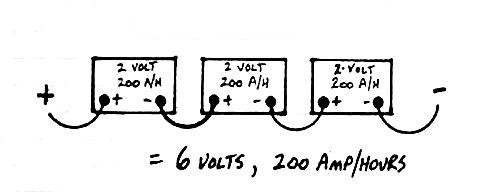 Parallel Wiring Example
Parallel Wiring Example
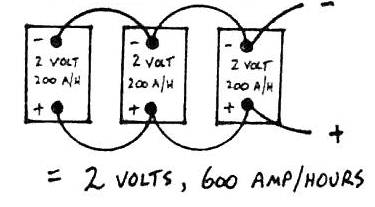 Typical remote power battery bank using 2 volt batteries
(series + parallel)
Typical remote power battery bank using 2 volt batteries
(series + parallel)
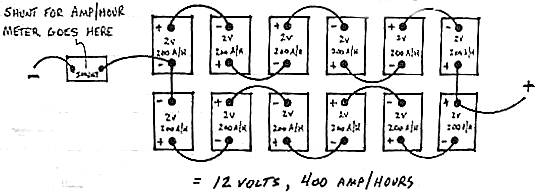 Typical remote power battery bank using 6 volt batteries
(series+parallel)
Typical remote power battery bank using 6 volt batteries
(series+parallel)
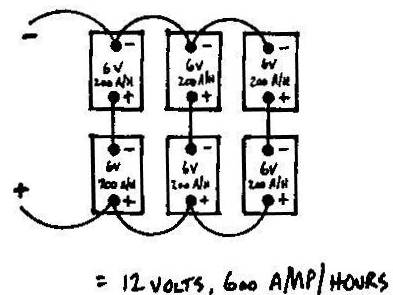 Battery Bank Wire Sizing
Batteries can put out a huge amount of power in a short time. It is important to use big enough wire for your series and parallel connections between the battery terminals (the interconnect wires) and to the inverter.
Note: We do not guarantee the accuracy of any of our information regarding whether it meets NEC code or not!
For BATTERY INTERCONNECT wires, use #4 gauge if you have a 500 watt or smaller inverter. Use #2 gauge for an 800 watt inverter, and go with #2/0 for larger inverters. If you can afford using #2/0 welding cable or can find a surplus deal on it (we did), we highly recommend it for battery interconnects no matter what size inverter you have since it is so flexible. Keep in mind that welding cable may not meet NEC code, even though it is clearly the best and safest choice (because of welding cables' flexibility, it puts little strain on the connection points) for battery and inverter wiring. Go figure!
Battery Bank Wire Sizing
Batteries can put out a huge amount of power in a short time. It is important to use big enough wire for your series and parallel connections between the battery terminals (the interconnect wires) and to the inverter.
Note: We do not guarantee the accuracy of any of our information regarding whether it meets NEC code or not!
For BATTERY INTERCONNECT wires, use #4 gauge if you have a 500 watt or smaller inverter. Use #2 gauge for an 800 watt inverter, and go with #2/0 for larger inverters. If you can afford using #2/0 welding cable or can find a surplus deal on it (we did), we highly recommend it for battery interconnects no matter what size inverter you have since it is so flexible. Keep in mind that welding cable may not meet NEC code, even though it is clearly the best and safest choice (because of welding cables' flexibility, it puts little strain on the connection points) for battery and inverter wiring. Go figure!Buss Bars It often saves a lot of trouble later to install + and - buss bars directly off of your battery bank, connected with wire thicker than what you need for your inverter These buss bars give you extra room to hook up new windmills, solar panels, meters, loads, etc. Use rectangles of at least 1/4" thick copper, drilled with extra holes. It's easy to tap threads into copper, too--this will speed your hookup time (no nuts necessary on the back side of the buss bar). If you have an amp/hour meter, it's shunt should go between the - (negative) buss bar and the battery bank so that all power collected and used is measured.
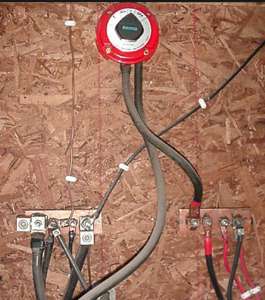 My buss bars and main power switch
My buss bars and main power switch